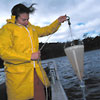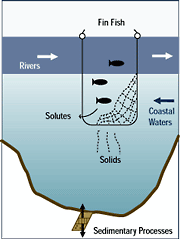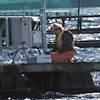

Outcomes for the Community
 In
1996, CSIRO Marine Research (now CSIRO Marine and Atmospheric Research),
the Fisheries Research and Development Corporation and marine farmers
Tassal Ltd and Huon Aquaculture Company
Pty Ltd made a major commitment
to investigate the factors influencing the environmental quality and workings
of the Huon Estuary. The project also gained support of the Huon Valley
Council and community groups, and came under the umbrella of the Huon
Healthy Rivers Project. In
1996, CSIRO Marine Research (now CSIRO Marine and Atmospheric Research),
the Fisheries Research and Development Corporation and marine farmers
Tassal Ltd and Huon Aquaculture Company
Pty Ltd made a major commitment
to investigate the factors influencing the environmental quality and workings
of the Huon Estuary. The project also gained support of the Huon Valley
Council and community groups, and came under the umbrella of the Huon
Healthy Rivers Project.
CSIRO and University of Tasmania environmental researchers began an
intensive program of sampling to record the natural, and sometimes human-influenced,
changes occurring in this valuable waterway. The three-year study has
involved over one hundred days of fieldwork on the waterway, development
and operation of novel automated monitoring equipment, thousands of analyses
in the laboratory, extensive data interpretation and the development
of computer models of the estuary. This work has culminated now in the
production of the project report.
 This research project has contributed to advancing environmental knowledge
of the Huon Estuary for more than 12,000 residents around the valley,
and those visiting the area who want to sample its natural attractions
and culture. The study will also underpin efforts by the aquaculture industry
and environmental managers to maintain a high quality estuarine environment,
and makes recommendations for maintaining the health of the ecosystem. This research project has contributed to advancing environmental knowledge
of the Huon Estuary for more than 12,000 residents around the valley,
and those visiting the area who want to sample its natural attractions
and culture. The study will also underpin efforts by the aquaculture industry
and environmental managers to maintain a high quality estuarine environment,
and makes recommendations for maintaining the health of the ecosystem.
[top]
An Environment Comes to Life
 High
water quality is vital to life in and around the Huon Estuary. High
water quality is vital to life in and around the Huon Estuary.
But it also varies from year to year, with the changing seasons and week
to week, after heavy rain in its catchment, or with strong winds and long
spells of warm weather.
So what conditions best suit two of the region’s most valuable industries
— raising salmon and farming shellfish? Are there critical conditions
that favour harmful algal blooms? Is occasional depletion of dissolved
oxygen in bottom waters an issue? Where do the nutrients in the estuary
come from?
The Huon Study began with four key aims:
-
To trace the links between water circulation, nutrients and algal
blooms;
-
Evaluate the processes such as fish farming and catchment run-off
that contribute organic matter to the system;
-
Determine the distribution and composition of organic material beneath
fish cages and how it is affected by fallowing; and
-
Helping to design a monitoring framework to record local and regional
influences on water quality.
 To
build their bank of information, scientists sampled year-round from Ranelagh
to Huon Island, as well as developing a sophisticated around-the-clock
water-quality assessment system. Special automated instruments measured
salinity, water temperature and microalgae through the water column, as
well as wind strength and direction, and light levels. To
build their bank of information, scientists sampled year-round from Ranelagh
to Huon Island, as well as developing a sophisticated around-the-clock
water-quality assessment system. Special automated instruments measured
salinity, water temperature and microalgae through the water column, as
well as wind strength and direction, and light levels.
[top]
How the Huon measures up?
In their 300-page technical report, scientists gave the Huon Estuary
an environmental all-clear, but called for an ongoing, whole-of-estuary
environmental monitoring and assessment strategy to guide the future use
of the estuary for marine farming (now the region’s largest employer)
and to watch over the catchment, which has a strong influence on the estuarine
environment.
[top]
Key Findings

- The water quality of the Huon Estuary is good, and that of its two
principal sources — the Huon River and the D’Entrecasteaux
Channel — is very high.
- The influence of land-based activities on the environmental quality
of the estuary appears to have had only localised effects to date.
- Two classes of algal blooms typically characterise the Huon Estuary
in the spring to autumn period of most years, one of which includes
the toxin-producing dinoflagellate, Gymnodinium catenatum.
- Organic matter accumulates in the sediments in summer, when the estuary
is more productive. Part of this is recycled rapidly to support more
summer production, part is stored temporarily and exported in winter,
and part may be permanently buried.
- Nitrogen distributions and algal production in the Huon Estuary under
present-day conditions are supported primarily by inputs from coastal
seawaters, and in that sense algal blooms should be regarded as natural.
However, available nitrogen from either fish farms, or washed off
the lower catchment from agricultural activities, may play a role
in stimulating algal blooms.
- Waste from fish cages is largely restricted to the area beneath the
cages.
- Fallowing, or resting fish farm sites, allows sediment conditions
to recover, but some of the added organic matter still remains one
year after the cages have been removed.
- 1997/98 levels of nutrient input from salmon farming were small compared
with naturally-occurring sources of nutrients. However, in a scenario
with twice that number of farmed fish, environmental changes are predicted
to occur; and at four times the number, the nutrients supplied by
farms are predicted to be sufficient to fuel prolonged and more intensive
algal blooms in the estuary.
[top]
Major Recommendation
 Marine
farming is but one of the many human activities putting pressure on coastal
ecosystems and it should not be the focus of undue or unfair attention.
A whole-of-estuary approach is needed that recognises all of the major
natural and human influences. By taking advantage of advances in technology
(autonomous environmental sensors), and improved scientific understanding,
there is now an opportunity to implement a cost-effective, integrated
monitoring and assessment strategy program for the Huon estuary and its
catchment. It will meet the operational needs of both marine farmers and
regulatory authorities for early warning of unsafe water quality or algal
blooms, and to promote prudent and enlightened development in the region
for the long term. Marine
farming is but one of the many human activities putting pressure on coastal
ecosystems and it should not be the focus of undue or unfair attention.
A whole-of-estuary approach is needed that recognises all of the major
natural and human influences. By taking advantage of advances in technology
(autonomous environmental sensors), and improved scientific understanding,
there is now an opportunity to implement a cost-effective, integrated
monitoring and assessment strategy program for the Huon estuary and its
catchment. It will meet the operational needs of both marine farmers and
regulatory authorities for early warning of unsafe water quality or algal
blooms, and to promote prudent and enlightened development in the region
for the long term.
[top]
What happens now?
 Information
collected during the three-year Huon Estuary Study will be a community
resource especially valuable in development planning. Information
collected during the three-year Huon Estuary Study will be a community
resource especially valuable in development planning.
Much of its value is as a standard against which to compare any changes
in water quality and functioning of the ecosystem.
For the aquaculture industry and its need for a clean marine environment,
this report provides integrated scientific knowledge with which to manage
new or existing leases and to develop cost-effective environmental monitoring
strategies.
While much of that information is technical, a more readily understood
interpretation of the study findings is being proposed with assistance
from the Fisheries Research and Development Corporation. The publication
is expected to be available in 2001/02.
[top]
About the Huon Estuary
 The
Huon Estuary is 40 kilometres long, with a surface area of more than 80
square kilometres. It is without question Tasmania’s most valuable
estuary, with salmon production and processing valued at more than $80
million. The
Huon Estuary is 40 kilometres long, with a surface area of more than 80
square kilometres. It is without question Tasmania’s most valuable
estuary, with salmon production and processing valued at more than $80
million.
The Estuary has a significant place in the history of development and
recreation in the Huon. Information obtained during three years of research
will stand as a reference for Australian environmental monitoring, and
as an important tool to aid development and recreational options for the
future.
[top]
Acknowledgements
 Members
of the CSIRO Huon Estuary Study team express their appreciation for the
considerable support and assistance provided to them by many organisations,
businesses and individuals. These include: Members
of the CSIRO Huon Estuary Study team express their appreciation for the
considerable support and assistance provided to them by many organisations,
businesses and individuals. These include:
- CSIRO Marine and Atmospheric Research
- Fisheries Research and Development Corporation
- Tassal Ltd
- Huon Aquaculture Company Pty Ltd
- Tasmanian Department of Primary Industries, Water and the Environment
- University of Tasmania
- Huon Valley Council
- Huon Healthy Rivers Project
- Kermandie Lodge
[top]
Further information and to download the report
Updated:
12/11/08

|
|